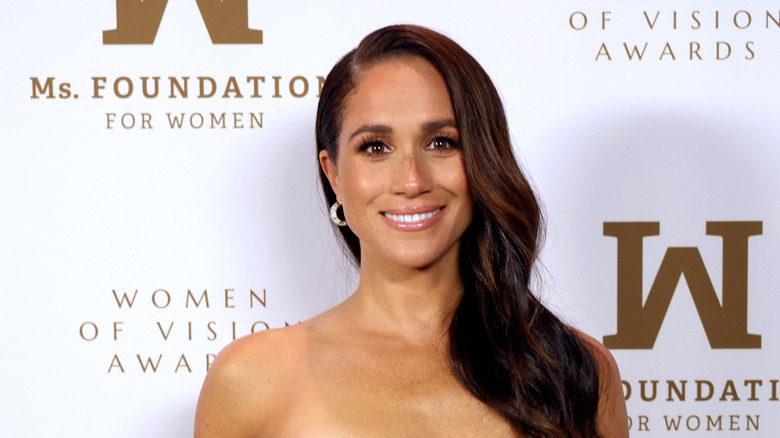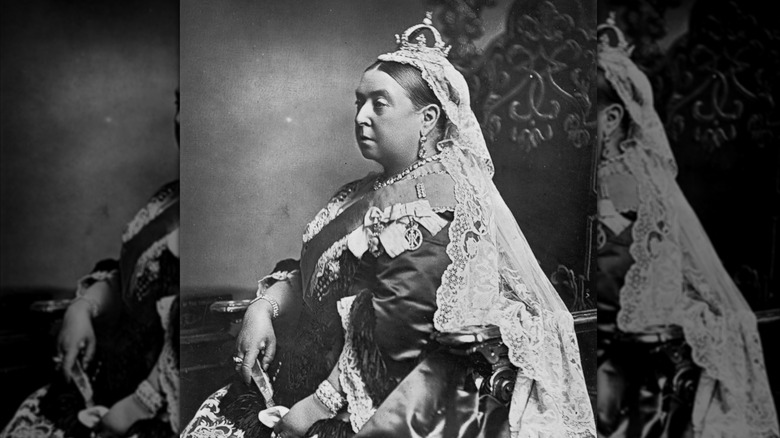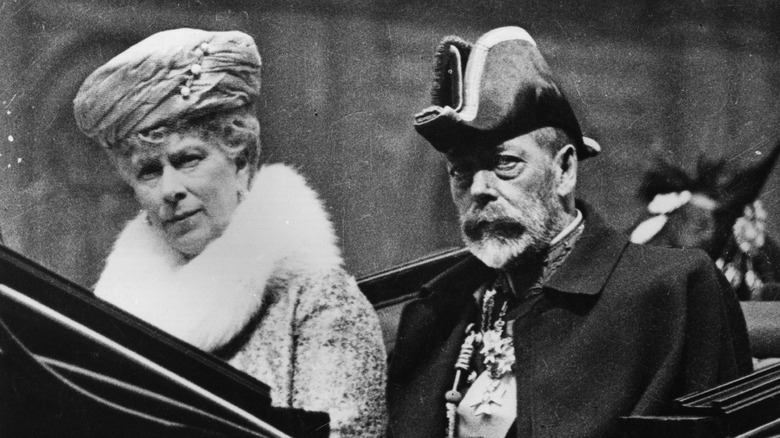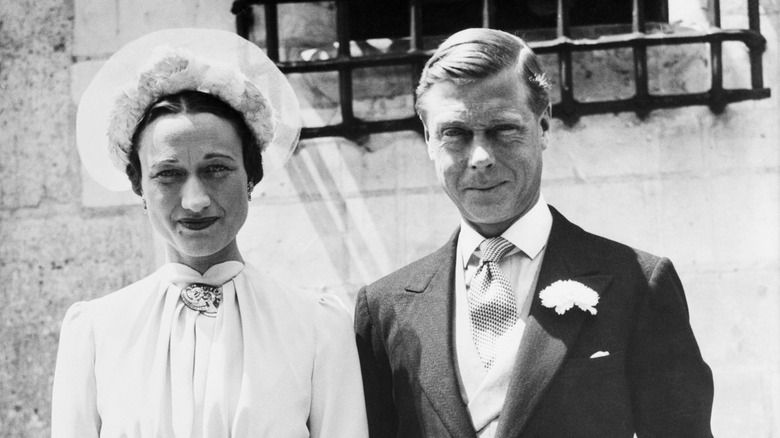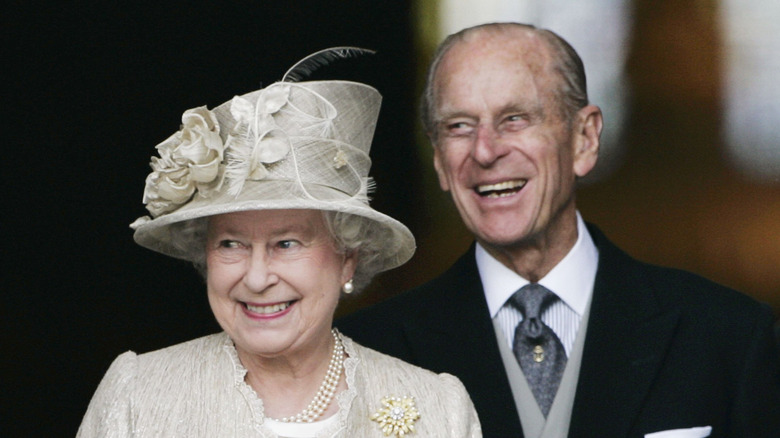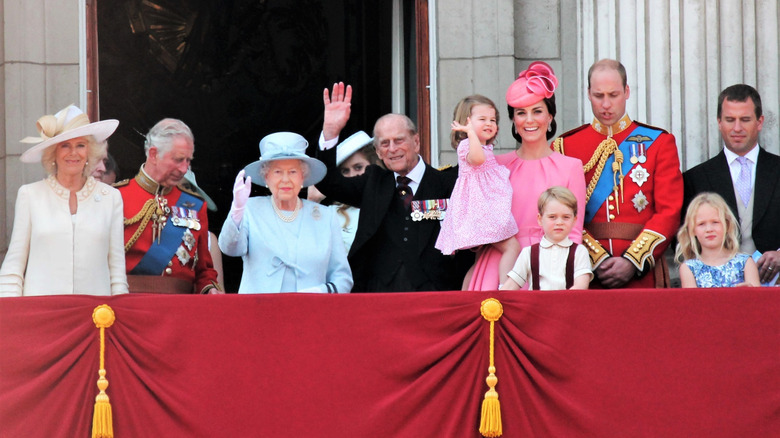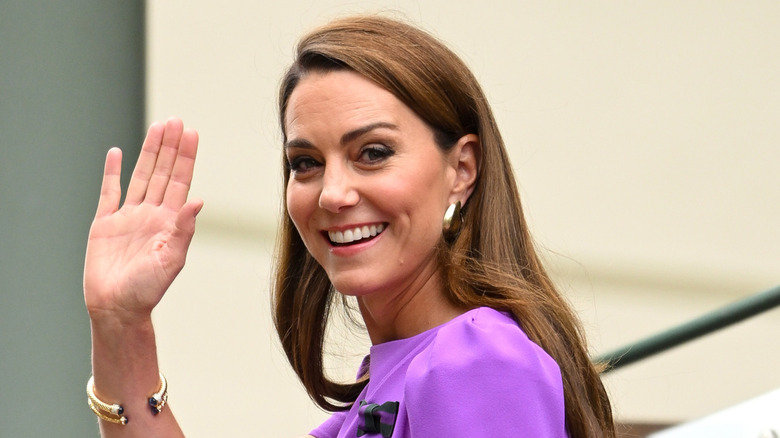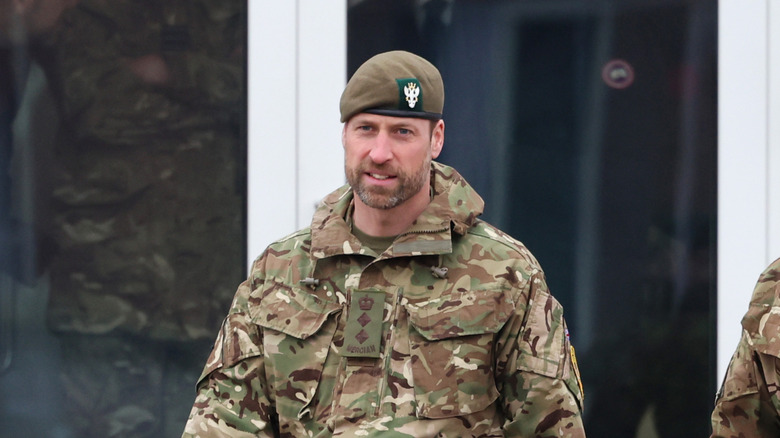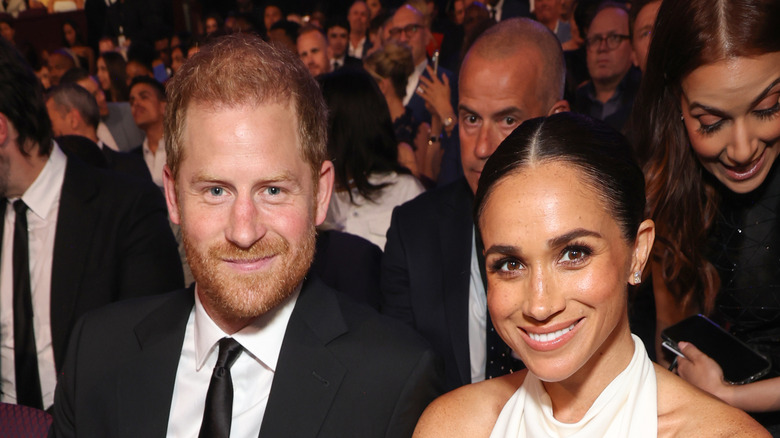8 Royals Who Made Confusing Name Changes
For anyone who watched Netflix's "With Love, Meghan," the moment where Meghan, Duchess of Sussex, corrects Mindy Kaling about her last name will quickly come to mind. This all happened because Kaling called her Meghan Markle, and Meghan corrected her. "It's so funny, too, that you keep saying 'Meghan Markle,'" Meghan said to Kaling. "You know I'm Sussex now." It stood out to viewers for many reasons, but one chief reason was that some legitimately didn't know what to call Meghan, and Kaling isn't the only one who refers to the star by her maiden name. Others took a more scathing approach. Some royal insiders say there's a shadier reason why Markle claims the name. But the truth is, Meghan Markle did change her last name, as confusing as it may be.
Perhaps surprisingly, name changes amongst the royal family aren't that uncommon — Meghan certainly isn't the only one to don a new moniker. Even Prince William and Catherine, Princess of Wales, have changed their names. Many heirs to the throne will change their name once they're crowned, too, so that creates a whole new level of name changes. In fact, the British royal family is rife with new names, title tweaks, and modified last names. It can be tough to keep track of, to say the least, but there's a logic behind almost every change.
Queen Victoria actually had a different first name
Queen Victoria, responsible for the eponymous Victorian era, was actually given a different first name at birth. It's a somewhat surprising detail, considering how profound the Victorian era – spanning from roughly 1820-1914 –was for Britain. There were huge developments in science, technology, culture, as well as art and literature. It's intriguing that this era, named after the queen (Victoria reigned from 1837 to 1901), didn't actually feature her real birth name.
She was born Alexandrina Victoria, and as a child, her nickname was "Drina," a playful shortening of her first name. However, when she became queen at 18, she chose her middle name, Victoria, as her regnal name (the name that the monarch chooses for their reign). Some monarchs, like King Charles III for instance, choose to keep their first name as their regnal name. But there's likely a sentimental reason as to why she chose the name Victoria; it was the queen's mother's name, and Victoria later named her eldest daughter Victoria, so it was something of a family tradition, and royals love using the same names throughout their lineage.
It wasn't just Victoria's regnal name that was interesting; the queen didn't have a last name at all. The British monarchy didn't use surnames until 1917, and instead they were referred to by the house that they belonged to. In Victoria's case, she was from the House of Hanover, a line that was originally German.
King George V changed the royal family name to Windsor
It was King George V who overhauled the royal family tradition of going without surnames. Previously, royals used the name of their house or dynasty. George had a strategic reason for changing this long-standing tradition. George became king in 1910, following the death of his father, King Edward VII, who was the child of Queen Victoria and her husband, Prince Albert. Edward VII, following the tradition of taking the names of the family house, went by the House of Saxe-Coburg-Gotha, a combination of German names that came from his German father.
As a result of World War I, there was a strong dislike of German influence in England, and in an effort to keep the royal family relevant as a national symbol, he wanted to erase this German ancestry. He chose the name Windsor in reference to Windsor Castle, a beloved royal residence in England. George declared that all male descendants of Queen Victoria would carry the name Windsor, as well as all unmarried females. All married women of the line would take their husbands' names, as was common practice. The name change was announced in The London Gazette on July 17, 1917.
"Now, therefore, We, out of Our Royal Will and Authority, do hereby declare and announce that as from the date of this Our Royal Proclamation Our House and Family shall be styled and known as the House and Family of Windsor," the announcement read, issuing a new moniker for the royal family.
Edward VIII had different names and titles over his life
King Edward VIII, who famously abdicated the throne in 1936 to marry the twice-divorced Wallis Simpson, went through several name changes throughout his life. When he was born on June 23, 1894, he was given the names Edward Albert Christian George Andrew Patrick David. With no shortage of names to choose from, his family and friends called him David as a child. This childhood nickname wouldn't last, though. When he became king in January 1936, following the death of his father, King George V, Edward kept his first given name as his regnal name, and became known as King Edward VIII.
However, his relationship with Simpson would prove to be impossible to reconcile with the crown. While Edward intended to marry her upon becoming king, her status as a divorcée didn't go down well with British society, and Edward was forced to choose between the two. So on December 10, 1936, Edward abdicated the throne, before his actual coronation even took place. His younger brother unexpectedly became King George VI, and the latter bequeathed on his once-kingly brother the title duke of Windsor, so Edward and Simpson became together the duke and duchess of Windsor. However, as one final dig, George VI refused to give Simpson the added ranking of "royal highness," which apparently was profoundly insulting to Edward. For his part, Edward was able to retain the ranking of "royal highness," still keeping something of his kingly pedigree.
Prince Philip changed his name when marrying Queen Elizabeth II
Prince Philip's life before he met Queen Elizabeth II was tragic and peripatetic, with roots far from England. He was born on June 10, 1921 on the Greek island of Corfu to Prince Andrew of Greece and Denmark and Princess Alice of Battenberg. His given name at birth was Prince Philippos of Greece and Denmark. However, when he was only 18 months old, in 1922, Philip and his family were exiled from Greece after his uncle, King Constantine I, was forced to abdicate. Philip lived in France, Germany, and Britain; with his family scattered across Europe, Philip's uncle, George Mountbatten, took charge of him and enrolled him in the Gordonstoun boarding school. It was around this time, when Philip was 14 and Elizabeth was eight, that they met for the first time. They met a second time, five years later, and this was when the romance began.
Philip and Elizabeth got engaged in July 1947 and married in November of the same year. But the wedding would cause considerable name changes. In order to marry the future monarch, he had to renounce his Danish and Greek royal titles. Plus, he took the name Mountbatten from his uncle. On his wedding day, Elizabeth's father, King George V, dubbed Philip "His Royal Highness" and made him the Duke of Edinburgh, the Earl of Merioneth, and the Baron Greenwich. In 1957, he was also made a Prince of the United Kingdom.
Queen Elizabeth II and Prince Philip named some of their descendants Mountbatten-Windsor
Queen Elizabeth II and Prince Philip changed the royal family name yet again in 1960. In order to reflect Philip's patronage, particularly his own name change to Mountbatten in 1947, they decided in the Privy Council that all their direct descendants would be given the hyphenated name Mountbatten-Windsor. So if any of the queen's children needed to use a last name, it would reflect both parents. There were a few exceptions, though. If an individual already had Royal Highness in their title, or were a prince or princess, it would not be required. Also, any women who married would not be required to use the updated last name, and would instead take her husband's name.
Using this criteria, Princes Harry and William did not use that last name. This is because they were given the HRH titles at birth. However, if they need the use of a surname, they have the option of using the one created by Elizabeth and Philip. Prince Edward's children, Lady Louise Mountbatten-Windsor and James, Viscount Severn, do go by the updated last name. The same goes for Harry and Meghan, Duchess of Sussex's children, Archie Mountbatten-Windsor and Lilibet Mountbatten-Windsor. That's right, even after all the times the royal family snubbed Harry and Meghan's children, they still carry the changed name that Elizabeth and Philip came up with for their lineage.
The former Kate Middleton asked everyone to call her Catherine
Catherine, Princess of Wales, has gone through her own name change evolution as a royal. Despite the fact that she's been in the spotlight for nearly two decades as Prince William's girlfriend and now wife, she's still commonly referred to as Kate Middleton, combining both a nickname and her maiden name. It can certainly make people wonder what we know about Kate Middleton's name and why no one calls her Catherine. While this is still a topic of conversation, Catherine was way ahead of it. In Robert Jobson's 2024 biography "Catherine, the Princess of Wales: A Biography of the Future Queen," he writes that as far back as 2008, Catherine was trying to evolve past her casual nickname. Jobson noted that Catherine sent a "humorous email" to friends that year, asking them to call her Catherine. "It was unclear if she did not like being called "Kate" or whether it was part of a bigger preparation for her formal public role as Prince William's future wife, but it appears that she had a genuine desire to go by her full name," Jobson wrote.
Sure enough, in October 2010, William proposed to Catherine in Kenya. Endearingly, Prince William and Catherine's proposal spot continues to be important in their lives. But even though Catherine has a ring on it, three children with William, and is utterly embedded in the royal family, she still gets called Kate sometimes.
Prince William's last name went from Wales to Cambridge and back to Wales
Prince William has had his own unique name changes throughout his life. In his early years, he was known as Prince William of Wales, which is interesting on a few different fronts. For one, Prince Charles reportedly wanted to name Prince William something else entirely. Secondly, William seemed to follow different rules from the rest of the royal family when it came to last names. Both William and his brother, Prince Harry, were born into His Royal Highness titles, meaning they didn't have to take the surname Mountbatten-Windsor, as chosen by Queen Elizabeth II and Prince Philip. Instead, when William (and Harry, for that matter) began school, they used Wales as a last name, since their father was the Prince of Wales at the time.
Then on April 29, 2011, his wedding day to Catherine, Princess of Wales, William became The Duke of Cambridge, Earl of Strathearn, and Baron Carrickfergus, while Catherine became Her Royal Highness The Duchess of Cambridge. Things changed again when his father became King Charles III on September 8, 2022. William became the heir apparent, and he inherited the title of Duke of Cornwall, and was made the Prince of Wales. He also became the Duke of Rothesay, Earl of Carrick, Baron of Renfrew, Lord of the Isles, and Prince and Great Steward of Scotland. That's a lot of titles to grow into.
Meghan Markle goes by Sussex now
Even before marrying a royal, Meghan, Duchess of Sussex, went through name changes. Born Rachel Meghan Markle, she decided to drop her first name as she pursued acting. But this wasn't the end of Meghan's changed names, particularly after she married Prince Harry on May 19, 2018. When they wed, Queen Elizabeth II gave them the titles Duke and Duchess of Sussex, and so Meghan officially became HRH Meghan, The Duchess of Sussex.
When Harry and Meghan stepped away from their royal duties, they lost the His or Her Royal Highness titles, but were allowed to keep their titles as the Duke and Duchess of Sussex. This is likely why she corrected Mindy Kaling on "With Love, Meghan." The famous clip "You know I'm Sussex now" revealed that Sussex is how she styles her name post-royal family. The Mountbatten-Windsor last name came into effect with Meghan and Harry's children, Prince Archie Harrison Mountbatten-Windsor and Princess Lilibet Diana Mountbatten-Windsor. However, it gets a little confusing because the royals never make names easy for anyone. When Meghan corrected Kaling about her Sussex surname, she stressed that it was important because it's the name that she shares with her children. So Sussex is a family name that both Archie and Lilibet share with their parents. For Meghan's part, using Sussex as her last name is a perfectly reasonable thing to do, much like how Prince William used Wales as a surname when he was a boy.
